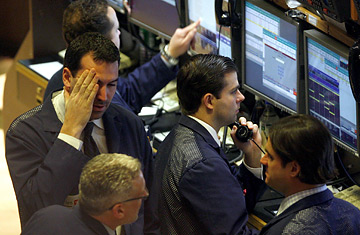
Traders work on the floor of the New York Stock Exchange
(2 of 2)
Credit markets are one worry; another is whether the rest of the world will be able to breeze along despite the U.S. slowdown. There are lots of signs that it'll be just fine, thanks. For the emerging economies of Asia, Africa and Latin America, these past five years have seen the best growth run in memory, and so far signs of slowdown outside the U.S. and Europe are few. India and China are posting astonishing growth numbers, while economies of countries from Africa to Latin America that export raw materials, like oil from Nigeria and copper from Chile, have benefited from high commodity prices — themselves a function of the Asian giants' performance. "The economic bleakness in the West I don't think is matched by economic bleakness in the East," says Kamal Nath, India's Minister of Commerce and Industry. There's so much growth momentum outside the U.S., argues C. Fred Bersten, head of the Peterson Institute of International Economics in Washington, that "a global recession is inconceivable."
That may be true for now, but Europe has seen some of the same warning signs as the U.S., including an overvalued housing market. A worldwide slump would be a special concern in poorer countries, says Ngozi Okonjo-Iweala, a former finance minister of Nigeria who is now a managing director of the World Bank. Food prices there, she notes, are already being driven up in part by demand for biofuels, which is leading to the substitution of food crops by those that can produce fuel. If food stays expensive yet economies in Africa and elsewhere slow, there could be big trouble.
For Americans, a global slowdown, short of a recession, wouldn't be all bad news. Exporters would benefit, though they account for only 12% of the economy. A gradual global slowdown would also give the Fed far more room to maneuver without the threat of stoking inflation. But there are downsides too: the U.S. would see high energy prices as Asia's demand for oil kept soaring, a continued dollar slump as low interest rates made it less attractive to hold dollar-denominated securities, and the threat of rising inflation as a weak dollar made imports more expensive. And a global recession (generally defined as growth of less than 2.5%; since the Depression, global growth hasn't actually gone backward) would be just plain bad news, depriving companies of the markets at home and abroad.
So the crucial question is whether the country's policymakers — in particular the Federal Reserve — are capable of steering the economy between the twin risks of a painfully deep recession and yet another bout of unsustainable, debt-fueled consumer spending. There seems to be little controversy over whether the Fed should ease rates, but there's lots of controversy over when and how much. The Jan. 22 rate cut came as a shock, but it did seem to calm the markets, if not buoy them.
The lesson here may be that there is no solution to the problems of the U.S. economy that won't involve some pain. One interesting dynamic that will play out over the next few years is that some people and some countries are in far better shape to weather a slowdown than others. Right now, the U.S. isn't one of them: with our trade deficits and federal budget deficits, we may be more vulnerable than other economies to the effects of a broad global downturn. And so whatever happens in the markets this year, you probably will not feel as house-proud as you did two years ago. Someone you know will be looking for a new job. And gas won't be getting much cheaper. The Fed can't magically make all that go away. Neither can Congress or the White House. The best they can do is keep it from getting any worse than it has to be.
The original version of this article incorrectly stated that consumers in China and India accounted for only $1.6 billion of the world's spending last year. In fact, they accounted for $1.6 trillion.
